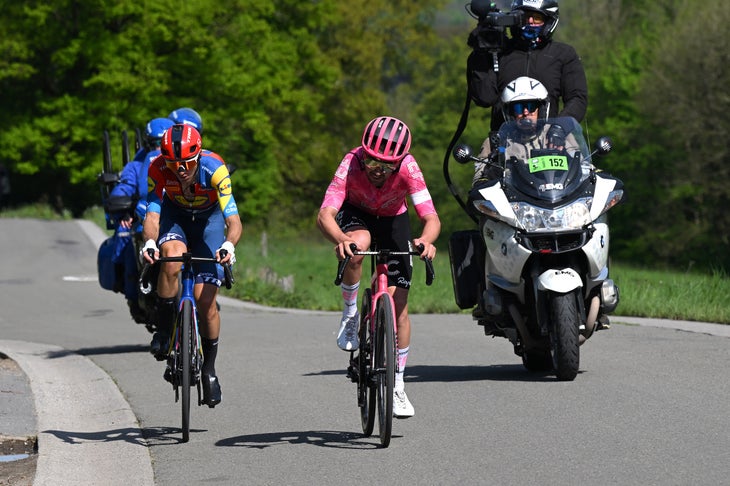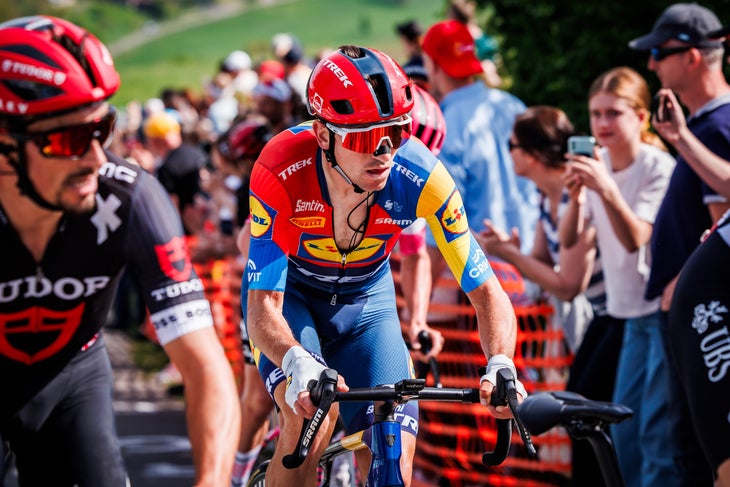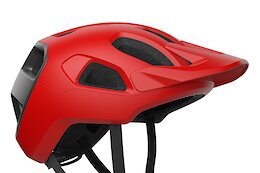Healy, Ciccone on Liège Tactics

“], “filter”: { “nextExceptions”: “img, blockquote, div”, “nextContainsExceptions”: “img, blockquote, a.btn, a.o-button”} }”>
The key to racing against Tadej Pogačar? Sometimes it’s to not race against Tadej Pogačar.
Or at least not on his terms.
Both Giulio Ciccone and Ben Healy noted that their strong performances in Liège-Bastogne-Liège on Sunday came after they made a conscious decision not to cross swords with the world champion.
Just as was the case in Wednesday’s Flèche Wallonne, Healy was at the business end of things when Pogačar made a decisive seated acceleration on the Côte de la Redoute.
Neither he, nor Ciccone, nor any other rider tried to go with the ultimate race winner when he surged.
Sometimes gambling and potentially settling for the podium rather than the win is the wisest decision.
“I would say to finish second behind Pogi … I don’t want to say it is like a victory, but it is a good feeling in the end,” Ciccone said after the race.
Healy concurred, although he did make clear the tactic was not necessarily about waving a white flag.
“We have seen so many times that Tadej has this nuclear attack on these climbs,” the Irishman said. “I just think if you follow, you burn yourself. Our plan all along was to try to set a steady tempo, or as steady as you can go.”
The reasoning behind the move was what happened to countless riders in the past. As Ben O’Connor, Matteo Jorgenson and Mattias Skjelmose noted last season, trying to cover a Pogačar attack is like flying too close to the sun. In other words, risking total failure.
Healy hoped that something like the outcome in the Amstel Gold Race could potentially happen.
To be more specific: allow him make his usual huge surge, give him rope, and gradually try to haul him back.
That’s what helped Remco Evenepoel and Mattias Skjelmose get him back last Sunday, and what led to Skjelmose’s victory in the race.
“You saw Ilan [Van Wilder, Evenepoel’s teammate – ed.] the other day in Amstel really held the gap and people were able to jump across,” Healy said.
“That was always our plan from the beginning, but it didn’t quite go that way. I think Tadej was just on another level.”
‘Everyone was pulling as hard as they could’

Pogačar showed an unexpected frailty in Amstel, but was more conservative in Flèche Wallonne and then destroyed the field on the Mur de Huy.
He made his move in Liège with just over 38km to go.
His surge saw him immediately get a gap, although he didn’t launch his usual out of the saddle burst of speed. Instead it appeared more controlled. He went over the top ten seconds ahead of Tom Pidcock (Q36.5 Pro Cycling), who in turn was just slightly ahead of Ciccone and Healy, and then continued to build time steadily over the next few kilometers.
Ciccone, Healy, Pidcock and Julian Alaphilippe (Tudor Pro Cycling) settled into a chase but while they stabilized the gap, they were unable to get him back.
Healy said they were fully committed.
“I think everyone was pulling as hard as they possibly could. I don’t think we were hanging around.
“We had a plan today and just tried to set a pace on La Redoute and let Tadej do his thing. Maybe we would have reeled him in. But he was a lot stronger today than he was in Amstel.”
Ciccone was guarded in his effort.
“Honestly, when he went I was just thinking of myself. I said, ‘okay, I do my tempo.’
“I know I don’t have the legs to follow him, so I just managed my energy in the best way.”
He had a particularly good reason to be cautious.
‘My feeling was not super’: Ciccone’s unconventional buildup

For many of the riders Sunday, their buildup to the race was Amstel Gold, then Flèche.
Ciccone followed a different route, most likely because he is aiming for the Giro d’Italia this year.
He took almost a month out of competition following Milan-San Remo, then lined out last Monday in the Tour of the Alps.
He won the opening stage there, took three top-5 placings on stages and finished fourth overall.
He then traveled to Belgium and, two days after the race finish in Italy, lined out in Liège.
It was an unorthodox approach, and he initially was under pressure.
“It was really hard, especially the first part,” he said. “My feeling was not super, I was a bit tired after the Tour of the Alps.
“But then in the final the last two hours the feeling was much better.
“Liege is one of my favorite races. I think after Lombardy this one means a lot for me.
“It makes me happy ten days or how many days it is before the Giro. Everything is fine.”
Healy, too, was smiling.
“I am super happy. First monument podium, and I am really happy I can pay the team back with this. They were great all the Ardennes campaign. I just want this [result] to settle in now.”
Still, as much as he felt satisfaction Sunday, as much as he was genuine in his congratulations of Pogačar, he very much wants to win Liège.
Embracing the Slovenian rider before the podium celebrations, he has just one question.
“When do you retire?”
“I have a contract until 2030,” Pogačar answered.
“Oh,” Healy sighed, then smiled.




